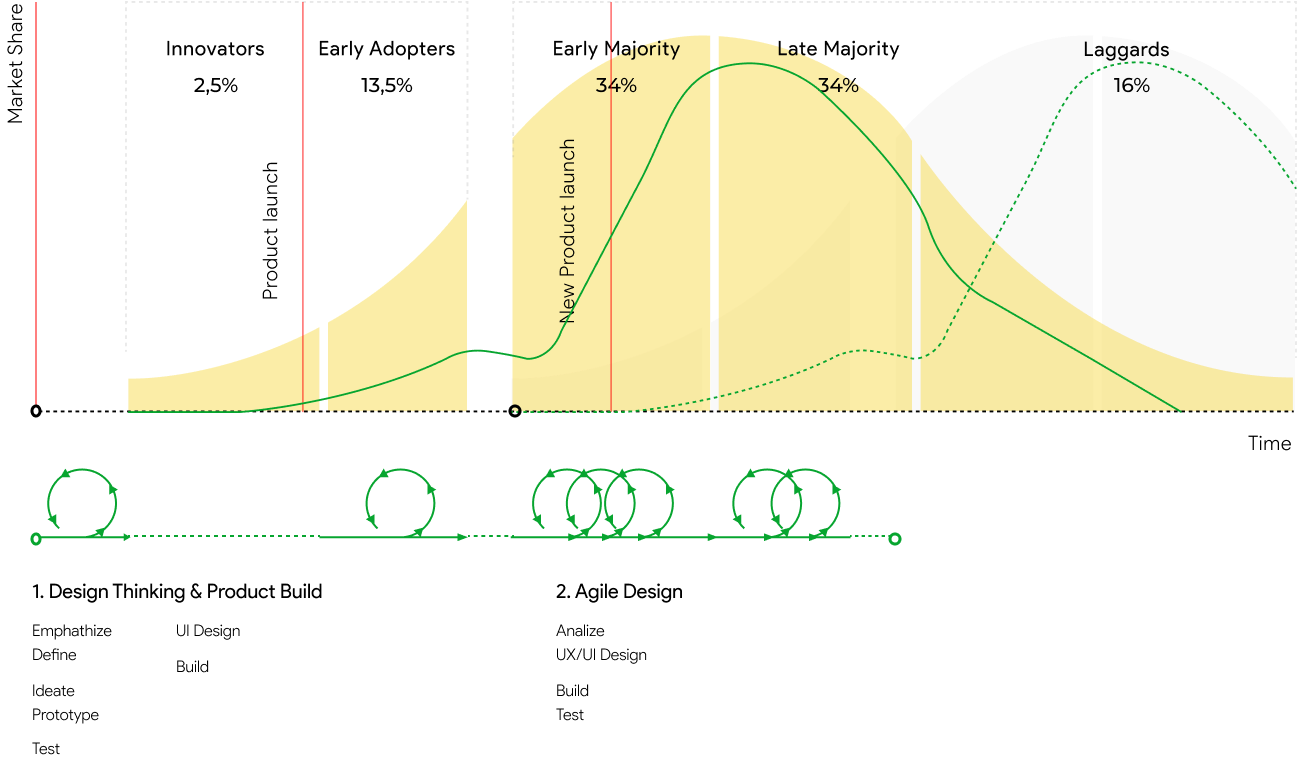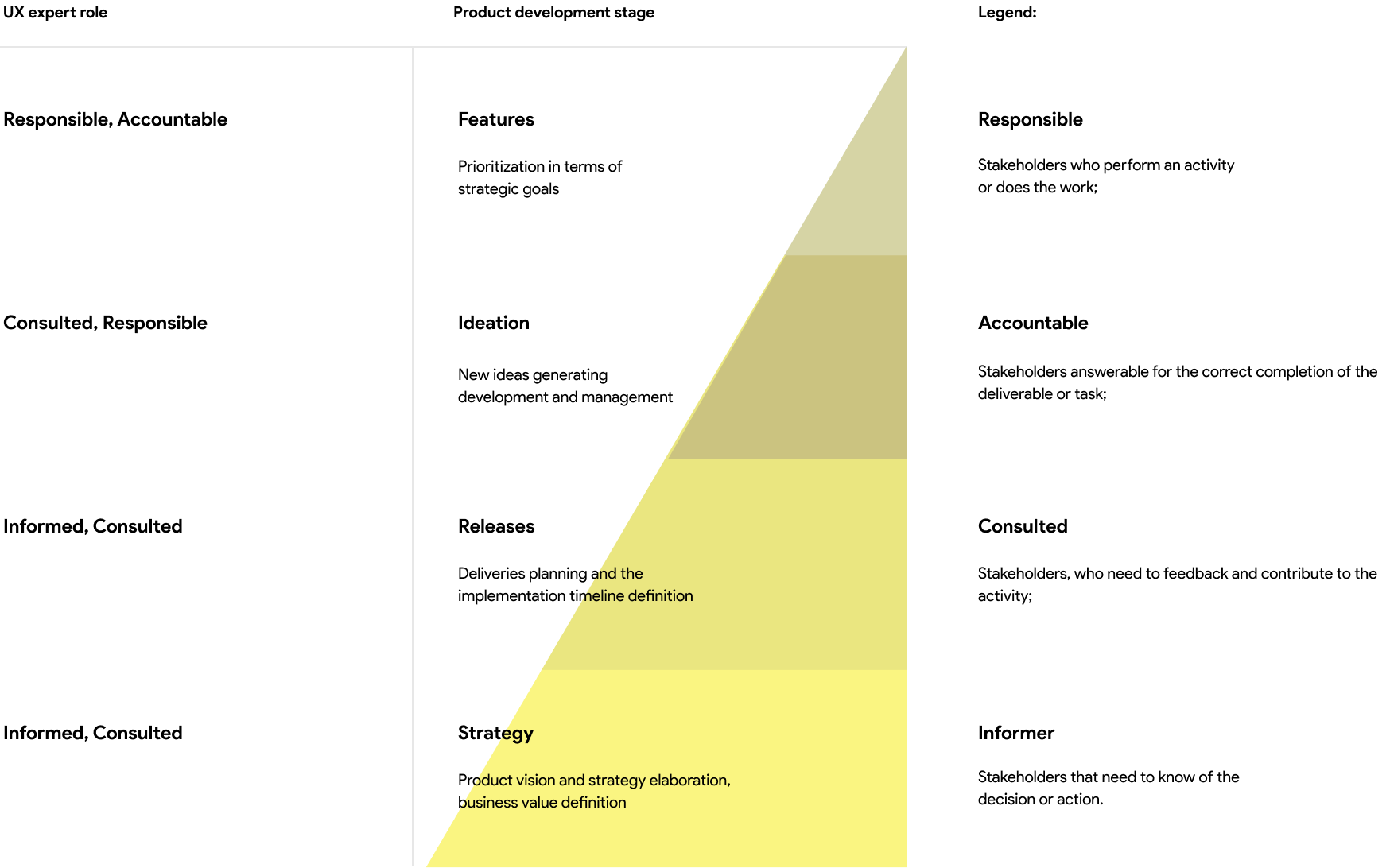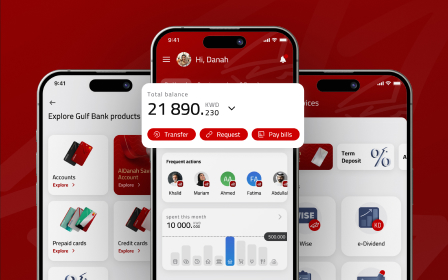Whitepaper: UX Design Impact on digital healthcare products adoption
From idea to mass market:
how UX design process can drive new healthcare product
market
adoption

Key takeaways
1. Health user adoption: how can UX help?
- Digital health apps adoption level in terms of categories does not exceed 8%, thus is far from winning the mass market.
- In healthcare UX takes a 50% share in gaining competitive advantage and a 33% share in preventing customer churn.
2. Healthcare apps UX: what does it take?
- Precise problem targeting, high learnability performance, and opinion leaders engagement are the core digital health apps adoption success drivers.
- To get better, digital healthcare apps UX design process should take into consideration new product adoption stages characteristics.
3. When the part of UX is crucial?
- Early product adoption stage. Appropriate UX techniques application defines product acceptance with the market early adopters.
- Entering the mass-market stage. Mass market entrance is always a challenge for new products. UX design process best practices application can enforce products’ crossing the innovation gap.

Introduction
If a company has a high user adoption rate, it’s an indication that far more individuals are adopting the product than are abandoning it. That usually means the company is acquiring new users very efficiently, and that leads it to grow. For most companies, high adoption is key to higher revenue.
According to Statista in the US, the number of adults, who use digital health
apps for health emergencies did not exceed 4%, for tracking illness and
medication - 5% and for measuring health metrics - 8% in 2017 [1].
In IMS Health
report [2], it is stated that
over 50% of these apps have a narrow functionality that limits their use in healthcare
and two-thirds of the apps merely provide information about medical conditions.
In addition, in [3] it was found that
95% of healthcare apps that are downloaded are never looked at or used only once.
UX impact on company performance
The latest analytics [4] shows, that user experience leaders gain rapid insights to build customer loyalty, achieve revenue gains of 5 to 10%, reduce costs by 15 to 25% within two or three years, same as decrease customer churn by 10 to 15% (Fig.1).
According to McKinsey [5], best design performers increase their revenues and shareholder returns at nearly twice the rate of their industry counterparts. These statistics are also fair for patient experience improvement effect and can be reached through user adoption increase. It takes providing a better user experience on the first hand.
UX value in healthcare
For the medical industry, the impact of UX on product success is higher than average across the industries. In terms of high competition and digitally savvy customer base, improvement of digital patient experience - easy access to information and good communication with doctors — can increase patient loyalty besides eliminating waste and reducing costs [10].
An effective, intuitive improve patient digital experience is to embrace UX design principles. Experts [6] outlined that , in healthcare, UX takes a 50% share in gaining competitive advantage and 33% share in customer retention rates increases. Basing on database collected in UX research by Genesis, only 3 core factors are defined as nowaday competitive advantage drivers: user experience, price, quality. In fig. 2 you can find each factor impact estimation on mHealth product competitiveness in terms of even investments by each factor. Circle radial describes the efficiency level.
This trend for the industry, in general, rises the high level of demands for the UX and usability of its’ digital products.

Fig. 2. Results of Healthcare Product Competitiveness Index Sensitivity
Analysis
Source: Copyright Qubstudio, based on US Customer Experience
Decision-Makers’ Guide (2018).
Digital health apps adoption success drivers
User adoption is the process by which new users become acclimated to a product or service and decide to keep. Statistics show that most of the digital health apps represented on the market do not match customers’ needs and provide low level of satisfaction in usage, what brings customers to negative user experience and ruins adoption process. Our analysis shows that among the core user adoption success drivers in digital health, we can outline the following:
1. Precise problem targeting.
Users only adopt a product if it helps them achieve a goal of theirs. Effective patient adoption strategies focus on the role of the patient and provider as partners in care. In order for patients to play an active role and develop a partnership with providers require assessing their ability to engage, understanding their health literacy, and helping them prepare and participate in their care interactions. These patient-centered approaches require a shift in care delivery as well as a person’s ability to manage their health conditions [10]. Thus, shift to patient-centered approach takes global rethinking of patients’ experience for clear patients problems targeting.
2. High learnability performance.
For digital healthcare, apps learnability level is one of the core adoption indicators, as these apps often are not used on a daily basis by a large percentage of patients. According to Statista U.S., the number of adults who regularly use the healthcare app does not exceed 8% [1]. Among medical professionals the frequency of apps usage is also low: 75.9% of respondents say they use mobile health in their practice only 0-5 hours per week [7].
3. Opinion leaders engagement.
Patients' adoption of mHealth apps can be increased through physicians' apps usage UX optimization.
The role of the physician is crucial in the health app patients’ engagement process. The physician is the core authority and opinion leader.
UX process adaptation to product lifecycle.
Healthcare is an innovation driven domain, where technology pushes often transform the market landscape. Thus, properly organised new product development process is crucial for market success. UX takes a significant part in new product effective development. Basing on [11] and our own new product development support experience, optimal UX Design techniques engagement can be organised as follows (see Table 1).
Table 1. UX design cycle in terms of product development
management (PDM)
stages

Source: Copyright Qubstudio LLC, based on [11]
In terms of innovation driven market, one should always keep in mind that new product development process should be preceded with iteration zero to obtain relevant market focus. Basing on the research undertaken in [12], on iteration zero market readiness to future product perception is to be analyzed (see Table 2).
Table 2. New mHealth product market perception evaluation

Source: Copyright Qubstudio LLC, based on [12]
Despite the fact that the approach described in Table 1 shows good results, in terms of new product market adoption, it’s effect is strictly limited. The common mistake is to relax, when the new product took a good start. According to new product adoption curve (see fig.3), only 2,5% of customers (‘innovators’) will accept the new product, designed according Table 1 approach for sure. 13,5% of users (‘early adopters’) are likely to accept new product if you’ll take under consideration recommendations from ‘innovators’, go back to review stages and make product updates (see feedback pass in Table 1).
On this stage product will come through the minor changes. Note that although the innovators and early adopters drive the technology markets, they are really only a small percentage of the market - 16%. The big market is with the pragmatists (‘early majority’) and the conservatives (‘late majority’) - 68% [9]. To cross the innovation gap and win the mass market it's important to repeat in general the product development process, shown in Tabl. 1, while moving from one customer segment to the other. The difference will lay just in UX design cycle emphasis as shown in Fig. 3.
Design Process at MedTech product Life Cycle

Fig.3. New product design approach in terms of adoption stages
Source: Copyright Qubstudio LLC, based on Rogers' bell curve and the Chasm
theory
To reach customer majority, it takes from producers to cross the innovations gap in the market.
When a product is targeting ‘innovators’ and ‘early adopters’, UX design process is focused on empathic design to define hidden market needs which could be transformed into future demand. It takes ideation, precise prototyping and user testing along with UI design and final product build. While entering the mass market, it takes from company an agile approach to design process as the key to success on this stage is to identify and target specific market segments in the early majority that will help to specify and create the whole product. This targeting takes a high flexibility level, which can be provided by agile approach. Following new product development is reasonable to start just after the first one reached the majority to increase the chances for its success not to miss the first-mover advantage* in dynamic market.
Entering the mass market takes an agile approach to design process as the key to success.
first-mover advantage* (FMA)
is the advantage gained by the initial ("first-moving") significant occupant of a market segment. A market participant has a first-mover advantage if it is the first entrant and gains a competitive advantage through control of resources.With this advantage, first-movers can be rewarded with huge profit margins and a monopoly-like status.
UX experts engagement
On fig. 4 the optimal engagement of UX expert for future product success is shown in terms of generalized product development stages.

Fig. 4. UX expert engagement by product development stages
Source: Copyright Qubstudio LLC, based on RACI matrix approach
It is highly important to engage UX experts in early stages of product planning, as UX expertise includes a cross-functional view at product development across all the product life cycle.

Fig. 5. The UX framework
Source: Copyright Envis Precisely GmbH, based on The Disciplines of User
Experience Design by Dan Saffer (2008)
UX framework (see fig. 5) shows that UX expert is supposed to combine knowledge in visual, interaction and information design, same as in marketing, informatics, systems architecture, human factors and many more. Such spread scope enables the following benefits of professional UX team engagement.
1. Capacity
Professional cross functional team is able to provide maximum amount of work within a given time period. It’s capacity will always be higher than an individual's, as they can provide any team composition needed for the task and exclude unpaid downtime situations.
2. Experience
Experienced agencies can bring with them a deep understanding of cases, the company is likely to face, the same as familiarity with the best practices to solve these challenges.
3. Risk management.
It is well known that fixing a problem in development costs 10x times more than in design, and 100x times more than in a released product. That’s why user experience expertise at early stages of product development is essential.
4. Product approach.
Experienced UX agency have a product management mindset, able to invest a lot into product strategy expansion and improvement.
5. Timeline.
Research [8] shows that professional design approach in product or service development process allows to reduce design time up to 75%, reduce development time up to 33% and to 2x speed up time to market.
6. Unbiased feedback.
External UX agencies are open to going back for additional idea validation, as they are o ft en provided payments aligned with final product pe rf ormance.
Summary
While the number of mHealth apps shows constant growth, user adoption of healthcare digital products remains unexpectedly low. This is caused by mHealth publishers’ drawbacks in proper meeting user goals, poor opinion leaders engagement and irrelevant UX performance, especially in terms of learnability.
For mHealth products to be able to engage customers and success in the adoption phase, it's crucial to take into consideration the new product market adoption cycle. When a product is targeting ‘innovators’ and ‘early adopters’, UX design process is to be driven with empathic design to define hidden market needs which could be transformed into future demand. It takes ideation, precise prototyping, and user testing along with UI design and final product build. While entering the mass market, it takes an agile approach to the design process as the key to success on this stage is to identify and target specific market segments in the early majority that will help to better specify and create the whole product. It is highly important to engage UX experts in the early stages of product planning, as UX expertise includes a cross-functional view at product development across all the product life cycles.
Resources
1. Statista.com: mHealth - Statistics & Facts
2. IMS Institute for Healthcare Information. Patient Adoption of mHealth
3. Ken Terry How to make health apps valuable for physicians and patients (2018)
5. McKinsey Quarterly. The Business Value of Design
6. The US Customer Experience Decision-Makers’ Guide 2018 (ContactBabel 2018)
7. 2018 Mobile Health Survey Results
8. The Total Economic Impact Of IBM’s Design Thinking Practice
About Qubstudio
Since 2007 we’ve been successfully helping businesses on every step of their lifecycle - from startups to enterprises.
Industry-based competence allows us to provide perfect fit out of the box UX solutions for websites and apps, the same as for complex enterprise systems.
With strong expertise across healthcare, fintech, retail, logistics and entertainment, we contribute to user-centered ecosystem development, where products, services, and businesses benefit from seamless interactions.

Den Sliusarchuk,
Head of Interaction design office at Qubstudio

Yaryna Demkiv, PhD
Business Analyst at Qubstudio
E-mail: box@qubstudio.com
Project team: +38(097)649-70-67
HR team: +38(097)480-79-94
Lviv, Ukraine
About Syte
Syte is a global strategy, reimbursement model and M&A advisory for Digital Health.

Syte focusses on global Digital Health strategy and business models in the pharma, Medtech and insurance industry, powered by global medical and economic data.
The Syte concept is a fast start with a combination of traditional and innovative digital services to support optimal growth.
Syte supports companies with cutting edge knowledge to face disruptive competition in the field of Digital health.

Dr. Andreas Keck, Dr. Med.
Founder at Strategy Institute for eHealth: SYTE
E-mail: info@syte-institute.com
Kurze Mühren 1
Hamburg, DE
https://ehealth-syte.com/




